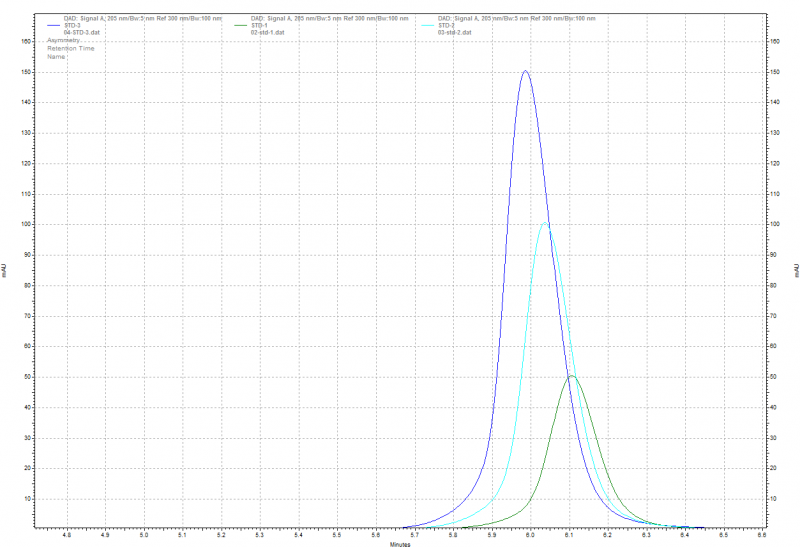-
- Posts: 175
- Joined: Thu Jul 26, 2007 2:13 pm

Advertisement
Discussions about HPLC, CE, TLC, SFC, and other "liquid phase" separation techniques.

Are you injecting the same volume for each standard?We use an Inertsil ODS-2 250mm x 4.6mm x 5µm column. Is it possible that the decrease in RTs with increasing concentration be caused by the sample diluent being different than starting MP conditions?
At the start of the gradient the composition is 98:2 10mmol potassium phosphate monobasic pH 3.2: ACN and our diluent is just plain 98 water:2 ACN. One interesting observation is that the RTs do not shift at a 1µl injection. Normal injection volume is 10µl
Retained peaks are not severely affected by the sample diluent. The peaks seem to show a non-classical fronting behaviour. If you overload further, then you would see either split peaks or much more clear fronting (shark fin type) peaks. If lower injection volume is not leading to mass overload, then why not try a lower injection volume?We use an Inertsil ODS-2 250mm x 4.6mm x 5µm column. Is it possible that the decrease in RTs with increasing concentration be caused by the sample diluent being different than starting MP conditions?
At the start of the gradient the composition is 98:2 10mmol potassium phosphate monobasic pH 3.2: ACN and our diluent is just plain 98 water:2 ACN. One interesting observation is that the RTs do not shift at a 1µl injection. Normal injection volume is 10µl
I'm thinking that most of what I inject is in the low ug/ml concentration range and I inject 10ul. Most of what we run here will give peak heights in the 30mAU and lower range instead of the 50-150mAU range like your peaks. If those three peaks covers the range of sample concentrations you need for your analysis, then you would easily get by with injecting 1-2ul of samples or even diluting the samples before injection.We inject the same volume for every injection.
I'm going to try a run with reduced injection volume. I actually thought about overload initially but 10µl of 0.5 mg/ml sample didn't seem like it would be enough to overload a 25cm column.
Separation Science offers free learning from the experts covering methods, applications, webinars, eSeminars, videos, tutorials for users of liquid chromatography, gas chromatography, mass spectrometry, sample preparation and related analytical techniques.
Subscribe to our eNewsletter with daily, weekly or monthly updates: Food & Beverage, Environmental, (Bio)Pharmaceutical, Bioclinical, Liquid Chromatography, Gas Chromatography and Mass Spectrometry.